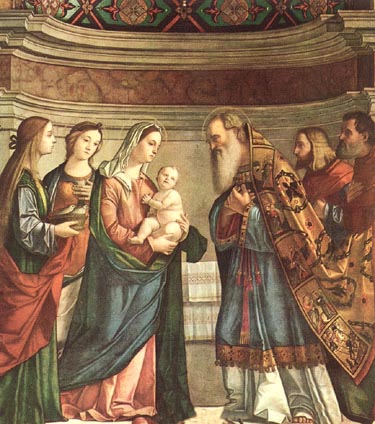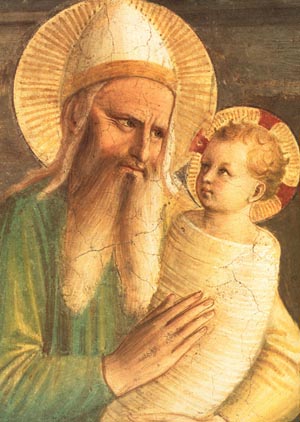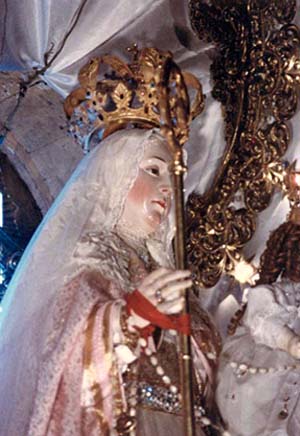 |
Feast Days of Our Lady
Our Lady of Good Success
and the Purification, February 2
Prof. Plinio Corrêa de Oliveira
Our Lady of Good Success! Our Lady of the Purification! What can be said about these two invocations? In what sense does the feast day of Good Success relate to the Feast of the Purification? And how can these invocations be understood in relation to our fight in the present days?

The Presentation in the Temple
|
According to the precept of the Old Testament, a mother would take her son 40 days after his birth to the Temple to present herself to be purified and to offer the child to God. This was a precept that every good Israelite mother observed. It was, moreover, a beautiful law that reflected the holiness of God.
A child is born amid the dangers that accompany every gestation. But, finally, he is born. Oh! Happy success! As soon as the mother recovers enough to travel, she takes the child and goes to the Temple. She goes and presents her child to God because He was the one who created him so he might be offered to God and live for Him. The Old Law made this presentation obligatory.
Because she did not have original sin, Our Lady was above the Old Law. Likewise Our Lord, who is God, was not subject to the Law that He Himself made. The Legislator is superior to the Law. So, in principle, He was not obliged to go, and Our Lady was not obliged to take Him to the Temple in Jerusalem. But she wanted to do so. She wanted to do this out of respect for the law, for tradition. Loving tradition and animated by her intense love for God, she took her Son, the Second Person of the Holy Trinity, to the Temple of Jerusalem.
Then we have the story in the Gospels on that episode at the Temple. It is God Incarnate Who enters the Temple built to worship Him. Even if the Temple had been much more splendid than the Temple of Jerusalem, it still would not have been sufficient for the Incarnate God to enter. It was the greatest hour, the blessed hour, the perfect hour. Never before in its history was the presence of God so intense and complete in that Temple as it was in that hour. One can say that at that moment, the angels filled the Temple and began to sing to celebrate the solemn moment. Our Lady entered holding Our Lord. Yet almost no one realized the magnitude of the event.
The religious decadence of the Chosen People was great at that time. The faithful were divided into two main currents: One wanted to adapt to the Greco-Roman influence that dominated the temporal world. They were the Saducees, in many points analogous to the present day progressivists. The other current pretended to follow the influential party of the Macabees and keep the old traditions of Israel. But unfortunately, this initial good intention had been deviated, and most of this group were now simply practicing a religion of formulas and rites, empty of any soul. They were the Pharisees, in many points similar to some false traditionalists of our days. Thirty years later, the heads of the Pharisees who revolted against the doctrine of Our Lord were the ones who led the plot to crucify Him.
At the time Our Lord was born, both currents were far from the right path of God. The Temple was filled with booths of people doing business of all kinds. Almost everything was in ruins, a moral decadence.

The Prophet Simeon receives the Child and recognizes Him as the Messiah
|
Then, the One Who is the Author of all things entered into this spiritual ruins. And those men of ruin did not perceive Who He was. He came to fulfill the ritual of presentation, and a prophet, Simeon, who was the Prophet chosen by God for this act of receiving the Son of God in the Temple, came forward. Receiving the Divine Child in his arms, he spoke the words of that canticle: “Nunc dimittis servum tuum Domine …”
“Now thou dost dismiss thy servant in peace, O Lord, according to thy word.
Because my eyes have seen my salvation,
Which thou hast prepared in the face of all peoples,
A Light to the revelation of the Gentiles and the glory of thy people Israel.”
Our Lady, joyous, heard these words spoken by that old man, who seemed embittered by life, by a promise that still had not been fulfilled. The promise of God that he would see the Messiah before he died. Then, when he saw the Messiah arrive, he cried out “Now, Lord, I can die in peace because my eyes have seen the Savior.”
He blessed them, and told the mother the future of that Child. He foresaw the Glory and the Cross. He said: “Behold this child is set for the fall and for the resurrection of many in Israel, and for a sign which shall be contradicted.”
The Prophetess Anna also sang the glories of the Child. By divine inspiration, Simeon and Anna were given to know that which until then only St. Joseph and Mary and a few others knew, that He was the Son of God.

Our Lady of Good Success
|
What is the relation of this event to Our Lady of Good Success? What is success? It is an event worthy of note, something that demands care, sacrifice, and dedication, and which gives a result. When this result is good, one says that it is a good success. There was much good success in the birth of Our Lord: the gestation of Our Lady was perfect; it was followed by a blessed and happy delivery, and the Child was healthy and perfect. Therefore, to commemorate such good success and to fulfill the precept of purification Our Lady took Him to the Temple.
In the broadest sense of the word, good success applies also to all those who carry out an arduous work, who take on a great responsibility, who desire to do difficult things to reach the result they were striving for. When their efforts are accomplished with the desired good result, they have a good success. Our Lady is the patroness of all those who seek a good success in the service of her cause.
You can see how apt it is for our days, how those who work and strive in the darkness of the night of the neopaganism of our days to see the sun of the Reign of Mary rise can rightfully call the result a good success. Can’t it be said that Our Lady of Good Success will be the so happily chosen patroness of the hour in which the Reign of Mary will finally be born on Earth?


  |
Prof. Plinio Corrêa de Oliveira
| |
The Saint of the Day features highlights from the lives of saints based on comments made by the late Prof. Plinio Corrêa de Oliveira. Following the example of St. John Bosco who used to make similar talks for the boys of his College, each evening it was Prof. Plinio’s custom to make a short commentary on the lives of the next day’s saint in a meeting for youth in order to encourage them in the practice of virtue and love for the Catholic Church. TIA thought that its readers could profit from these valuable commentaries.
The texts of both the biographical data and the comments come from personal notes taken by Atila S. Guimarães from 1964 to 1995. Given the fact that the source is a personal notebook, it is possible that at times the biographic notes transcribed here will not rigorously follow the original text read by Prof. Plinio. The commentaries have also been adapted and translated for TIA’s site.
|
Saint of the Day | Home | Books | CDs | Search | Contact Us | Donate

© 2002- Tradition in Action, Inc. All Rights Reserved
|
 |

|